
Bermondsey is a district in South East London in the London Borough of Southwark, England, 2.5 miles (4.0 km) southeast of Charing Cross. To the west of Bermondsey lies Southwark, to the east Rotherhithe and Deptford, to the south Walworth and Peckham, and to the north is Wapping across the River Thames. It lies within the historic county boundaries of Surrey.

Newington is a district of South London, just south of the River Thames, and part of the London Borough of Southwark. It was an ancient parish and the site of the early administration of the county of Surrey. It was the location of the County of London Sessions House from 1917, in a building now occupied by the Inner London Crown Court.
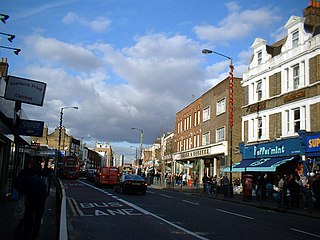
Walworth is a district of south London, England, within the London Borough of Southwark. It adjoins Camberwell to the south and Elephant and Castle to the north, and is 1.9 miles (3.1 km) south-east of Charing Cross.

The London Inner Ring Road, or Ring Road as signposted, is a 12-mile (19 km) route with an average diameter of 2.75–5.5 miles (4.43–8.85 km) formed from a number of major roads that encircle Central London. The ring road forms the boundary of the London congestion charge zone, although the ring road itself is not part of the zone.

The Elephant and Castle is an area around a major road junction in London, England, in the London Borough of Southwark. The name also informally refers to much of Walworth and Newington, due to the proximity of the London Underground station of the same name. The name is derived from a local coaching inn. In the first half of the 20th century, because of its vitality, the area was known as "the Piccadilly of South London". However, in more recent years is now viewed as a part of central London given its location in Zone 1 on the London Underground.

New Kent Road is a 1 kilometre (0.6 mi) road in the London Borough of Southwark. The road was created in 1751 when the Turnpike Trust upgraded a local footpath. This was done as part of the general road improvements associated with the creation of Westminster Bridge; in effect it was possible to travel from the West End/ Westminster to the south-east without having to go via the Borough of Southwark but could now cross St George's Fields to the junction of Newington Causeway and Newington Butts which is where New Kent Road starts at Elephant and Castle. The route runs eastward for a few hundred yards to the junction of Great Dover Street and Tower Bridge Road, known as Bricklayers Arms, where it joins the original route to the south-east Old Kent Road.
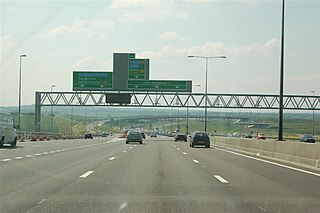
The A2 is a major road in south-east England, connecting London with the English Channel port of Dover in Kent. This route has always been of importance as a connection between London and sea trade routes to Continental Europe. It was originally known as the Dover Road.
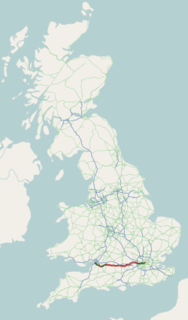
The A4 is a major road in England from Central London to Avonmouth via Heathrow Airport, Reading, Bath and Bristol. It is historically known as the Bath Road with newer sections including the Great West Road and Portway. The road was once the main route from London to Bath, Bristol and the west of England and formed, after the A40, the second main western artery from London.

Old Kent Road is a major thoroughfare in South East London, England, passing through the London Borough of Southwark. It was originally part of an ancient trackway that was paved by the Romans and used by the Anglo-Saxons who named it Wæcelinga Stræt. It is now part of the A2, a major road from London to Dover. The road was important in Roman times linking London to the coast at Richborough and Dover via Canterbury. It was a route for pilgrims in the Middle Ages as portrayed in Chaucer's Canterbury Tales, when Old Kent Road was known as Kent Street. The route was used by soldiers returning from the Battle of Agincourt.
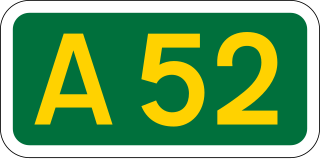
The A52 is a major road in the East Midlands, England. It runs east from a junction with the A53 at Newcastle-under-Lyme near Stoke-on-Trent via Ashbourne, Derby, Stapleford, Nottingham, West Bridgford, Bingham, Grantham, Boston and Skegness to the east Lincolnshire coast at Mablethorpe. It is approximately 147 miles (237 km) long.
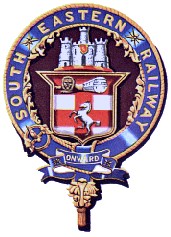
The South Eastern Railway (SER) was a railway company in south-eastern England from 1836 until 1922. The company was formed to construct a route from London to Dover. Branch lines were later opened to Tunbridge Wells, Hastings, Canterbury and other places in Kent. The SER absorbed or leased other railways, some older than itself, including the London and Greenwich Railway and the Canterbury and Whitstable Railway. Most of the company's routes were in Kent, eastern Sussex and the London suburbs, with a long cross-country route from Redhill in Surrey to Reading, Berkshire.
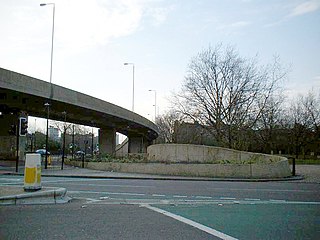
Great Dover Street is a road in Southwark, south London, England. At the northwest end it joins Marshalsea Road and Borough High Street and there is a junction with Long Lane; Borough Underground station is at this location. At the southeast end is the Bricklayers Arms roundabout and flyover. The road is part of the A2 and this continues south-east as the Old Kent Road.

The A201 is an A road in London running from Kings Cross to Bricklayer's Arms.
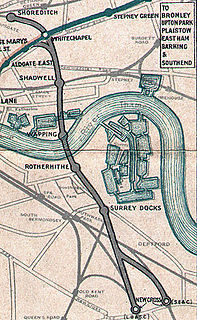
Old Kent Road was a railway station on the London, Brighton and South Coast Railway line in south London which took its name from the Old Kent Road on which it was located. The station opened on 13 August 1866 on a viaduct and bridge crossing the road at a junction with a line to London Bridge station and what became Surrey Quays station on the East London Line and Queens Road Peckham station on the South London Line. The station was renamed in 1870 to Old Kent Road and Hatcham. The passenger train service to East London was withdrawn on 1 June 1911 and the track was removed in 1912. The station closed temporarily on 1 January 1917 during the First World War as an economy measure, but was never reopened after the end of the war.

The Bakerloo line extension is a proposed extension of the London Underground Bakerloo line in South London from its current terminus at Elephant & Castle to Lewisham station.

The A40 is a major trunk road connecting London to Fishguard, Wales. The A40 in London passes through seven London Boroughs: the City of London, Camden, Westminster, Kensington & Chelsea, Hammersmith & Fulham, Ealing and Hillingdon, to meet the M40 motorway junction 1 at Denham, Buckinghamshire.

Long Lane is a main east-west road in Southwark, south London, England.
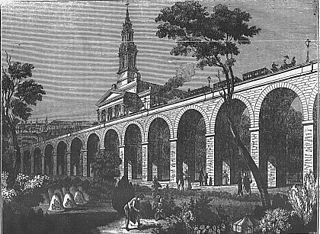
The London Bridge – Greenwich Railway Viaduct consists of a series of nineteen brick railway viaducts linked by road bridges between London Bridge railway station and Deptford Creek, which together make a single structure 3.45 miles (5.55 km) in length. The structure carries the former London and Greenwich Railway line and consists of 851 semi-circular arches and 27 skew arches or road bridges. It is the longest run of arches in Britain, It is also one of the oldest railway viaducts in the world, and the earliest example of an entirely elevated railway line. It was built between 1834 and 1836. The original viaduct had been widened for 1.95 miles (3.14 km) of its length between Corbett's Lane and London Bridge on the south side to accommodate the trains of the London and Croydon Railway and London and Brighton Railway, in 1842 and also for 2.65 miles (4.26 km) on the north side to accommodate the South Eastern Railway main line in 1850. It is a Grade II listed structure.

Bricklayers Arms was a railway station in Southwark opened by the London and Croydon Railway and the South Eastern Railway in 1844 as an alternative to the London and Greenwich Railway's terminus at London Bridge. The station was at the end of a short branch line from the main line to London Bridge and served as a passenger terminus for a few years before being converted to a goods station and engineering facility. The goods station closed in 1981.
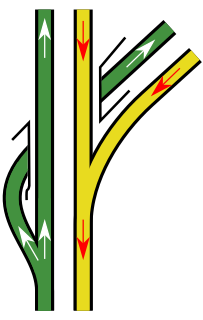
The Bermondsey dive-under is a significant piece of rail infrastructure to the south of London Bridge Station in Bermondsey, London. A dive-under is where one set of rail lines tunnel under another set instead of crossing them on the level, this allows for independent running and increases the capacity of both tracks. For historical reasons, Bermondsey was a point of congestion where tracks from Kent heading to Charing Cross station had to cross the tracks coming from Sussex and running north to terminate at London Bridge or through to Blackfriars.























